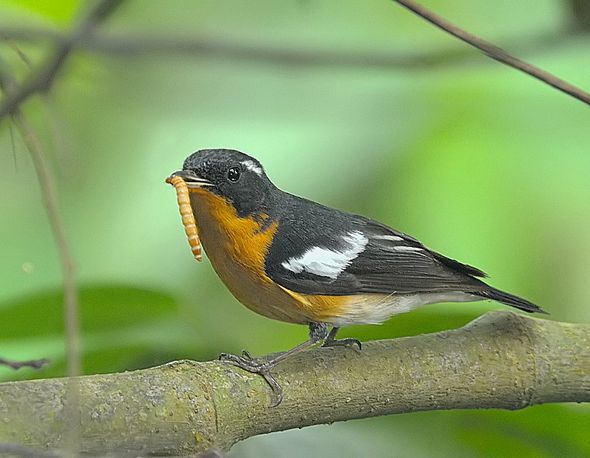Chan Wei Luen’s (a.k.a. luenny) image of a Mugimaki Flycatcher (Ficedula mugimaki) with an insect larva in its bill is a contribution to the food habits of this flycatcher*.
According to Boles (2006), the food of the Mugimaki Flycatcher is largely unknown but “includes small invertebrates; also some seeds and fruit, e.g. berries.”
The bird is usually solitary or in pairs, sometimes in small groups when on passage and in wintering areas. It forages around the middle to upper levels of the tree canopy in the forest edge and in forest clearings. From a lookout perch, it sallies forth in pursuit of flying insects, often returning to a different perch. It also hovers-gleans from foliage and flowering heads. It even picks prey from the ground, but not often.
The Mugimaki Flycatcher breeds in E Russia, N China and Japan, wintering in Southeast Asia .
Chan Wei Luen.
Singapore
June 2010
Reference:
Boles, W. E., 2006. Family Rhipiduridae (Fantails). In: del Hoyo, J., A. Elliott & D. A. Christie (eds.). Handbook of the birds of the world. Vol. 11. Old World Flycatchers to Old World Warblers. Lynx Editions, Barcelona. Pp. 200-242.
This post is a cooperative effort between NaturePixels.org and BESG to bring the study of bird behaviour through photography to a wider audience.
*NOTE: We thank Dave Bakewell for pointing out that the larva can be a mealworm. According to Dr Leong Tzi Ming, “Mealworms that are commercially available are essentially the larvae of beetles, which would be spending most/all their larval stage well hidden away in dead/dying wood, or underground. I would imagine only excavating birds (e.g. woodpeckers, barbets) to actively seek them out successfully. Hence, it is my opinion that a Mugimaki Flycatcher, with such a short, weak bill would be incapable of extracting a beetle grub from its hiding area in wood. But if a handful of such mealworms were offered by a cunning/desperate photographer, why would it refuse?” For the records, the photographer simply provided the image, I identified the prey and made the claims. My apologies. YC










6 Responses
This kind of photographic documentation is extraordinarily useful. We know very little about the foraging of forest birds in SE Asia. In this case, it might even be possible for an entomologist to identify that larva.
We at BESG totally agree. In fact we have been trying hard to persuade birdwatchers to carry a camera with limited success.
I’m no entomologist, but that grub looks suspiciously like a mealworm, brought from a petshop and put out as ‘bait’ by the photographer. If it is, then it probably tells us very little about the species’ feeding ecology. There’s a photograph of a similar bird tackling a veritable mountain of mealworms viewable here: http://www.photomalaysia.com/forums/showthread.php?t=120466&highlight=mugimaki if you are a member of the forum.
Whether or not the increasingly common practice of photographers using mealworms as bait is in the long-term best interests of the birds concerned (particularly residents feeding young) is perhaps something for BESG members to research. At the very least, I would suggest that, when a photographer has used mealworms as bait to get a photo, he or she ‘comes clean’ and mentions this.
I have to agree with Dave on this one. The link you sent was great. A bit of an overkill with the meal worms there though. I have witnessed for myself how photographers would throw a dead fish to lure White Bellied Sea eagles for a good “swoop down” pose. Even stork billed kingfishers have been lured in similar fashion.
While this technique has been debated before between photograpers in some forums, it seems to be tolerated here. I think a little bit of discretion should be applied with regards to such lure feedings. Photographers should not be too engrossed with capturing the perfect shot at the expense of the subjetcs’ long-term well-being.
We have made modifications to the post in view of Dave Bakewell’s comment and Dr Leong Tzi Ming’s input.